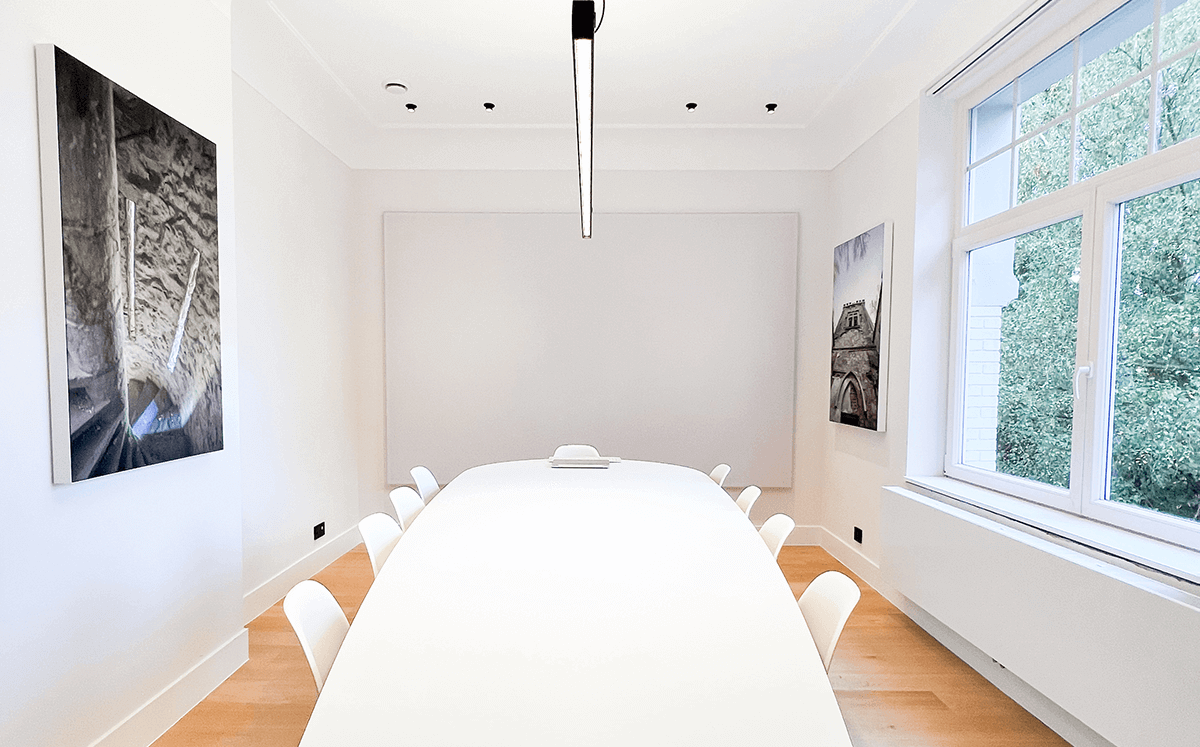In modern meeting rooms, speech intelligibility determines the quality of exchanges both in person and in videoconferencing. Excessive reverberation causes fatigue, blurs voices, and makes everyone speak louder. Phono ART is a sound absorption solution designed to bring reverberation time back into a comfort range suited to professional use, with aesthetic integration on the ceiling and/or walls.
Why treat reverberation in meeting rooms?
A “beautiful but echoey” room quickly becomes underused. From 4–6 people upwards, first reflections and echo degrade comprehension, increase listening effort, and disrupt VC/AV performance. By bringing RT toward a comfort target (Phonotech internal reference for meeting rooms: about 0.77 s, to be adjusted according to volume and materials), Phono ART stabilizes speech, reduces cognitive fatigue, and directly improves the employee experience.
What Phono ART delivers
- Speech clarity: intelligible 360° speech, natural, unforced voices.
- Videoconference compatibility: better mic capture, fewer algorithm artifacts.
- Usability comfort: shorter meetings, faster decisions, fewer repetitions.
- Design: aesthetic panels, combinable formats and finishes (walls and ceiling).
Implementation principles for meeting rooms
Treatment targets the areas where acoustic energy concentrates and reflects toward listeners.
- Ceiling: priority no. 1 to break global reflections, above the table and along the conversation axis.
- Walls near speakers: treat first reflections to improve intelligibility and mic pickup.
- Distribution: avoid “everything in one spot”; prefer a homogeneous spread over a single “hot zone.”
- Clearance & equipment: coordinate with lighting, sprinklers, sensors, and VC cameras.
Design best practices
- Clear objective: set the comfort target (e.g., ~0.77 s) by volume, use, and furniture.
- Surfaces: combine ceiling + vertical planes to avoid “spotlight” acoustics.
- Table & furniture: avoid large, perfectly parallel hard surfaces left uncompensated.
- AV compatibility: plan absorption at speaking zones and within camera cones.
Phonotech project method
- Express diagnosis: on-site survey, measurements/estimates, priorities by room.
- Concept & layout: choose treated surfaces, Phono ART formats, finishes.
- Pilot: before/after test area, user feedback, setting validation.
- Rollout: clean, quick installation in occupied sites, coordination with other trades.
- Handover & follow-up: checks, fine-tuning, usage recommendations.
Integration within the Phonotech ecosystem
Phono ART is part of our sound absorption offer for tertiary spaces. For office environments broadly (no EN page available), see the FR reference: Acoustique – Bureaux. Phonotech case studies (e.g., Liège Expo, Ethias Arena) demonstrate the impact of well-managed sound design. Technical docs and installation manuals: Documents and Assembly instructions. To talk to an acoustics expert, visit Contact.
FAQ – Phono ART in meeting rooms
How much Phono ART surface should I plan?
It depends on room volume, materials, and the comfort target. Our teams size the solution from your inputs and calibrated references for reliable, reproducible results—without burdening you with calculations.
Walls or ceiling?
The ceiling generally comes first to stabilize the global response. Wall complements at first reflections greatly improve intelligibility and mic pickup.
Is installation possible in occupied sites?
Yes. Phono ART layouts enable quick, clean interventions with appropriate phasing.
Is Phono ART enough if noise comes from other rooms?
Phono ART treats in-room reverberation. If noise comes from elsewhere, a complementary acoustic insulation solution (partitions, doors, junctions) will be assessed.
Calls to action
- Understand the approach: Sound absorption
- See real cases: Case studies
- Speak with an expert: Contact
